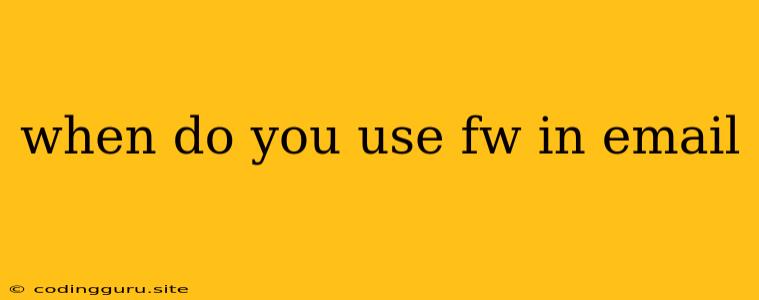When Do You Use "FW" in an Email?
The use of "FW" in an email subject line often leaves people wondering, "What does this even mean?" It's short for "Forwarded" and is a common practice in email communication, but knowing when and how to use it is key to maintaining clear and effective communication.
What Does "FW" Mean in an Email?
Simply put, "FW" in an email subject line indicates that the email you're receiving is a forwarded message. This means the original sender received the email from someone else and is now passing it on to you.
Why Use "FW" in an Email Subject Line?
Using "FW" in the subject line serves several important purposes:
- Clarity: It clearly identifies the email as a forwarded message, preventing confusion about its origin.
- Context: It provides context for the recipient, helping them understand the email's purpose and potential relevance to them.
- Efficiency: It saves time by indicating that the recipient doesn't need to read through the entire original email chain to understand the context.
When Should You Use "FW" in an Email Subject Line?
While using "FW" is generally considered good practice, there are specific situations where it's particularly beneficial:
- Forwarding Multiple Emails: When forwarding multiple emails to a single recipient, using "FW" in the subject line helps maintain clarity and prevents the recipient from being overwhelmed by a long email chain.
- Forwarding Emails with Sensitive Information: If you're forwarding an email containing sensitive information, using "FW" can ensure the recipient understands the importance of maintaining confidentiality.
- Forwarding Emails with Time-Sensitive Information: When forwarding an email containing urgent information, "FW" can highlight the urgency and encourage the recipient to act quickly.
How to Use "FW" in an Email Subject Line:
- Formatting: Typically, "FW" is placed at the beginning of the subject line followed by a colon and a brief description of the forwarded message.
- Example: "FW: Meeting Agenda"
Alternatives to "FW" in Email Subject Lines:
- "Fwd": A common abbreviation for "Forwarded," often used interchangeably with "FW."
- "Re:": This signifies "Regarding" and is used when replying to an email. While it's not strictly a "FW" alternative, it can be used to indicate the email's relation to a previous conversation.
- "Original Message": This phrase is used when you want to emphasize that the email you're forwarding is the original message.
When Not to Use "FW" in an Email Subject Line:
- Forwarding to the Original Sender: If you're forwarding an email back to the original sender, there's no need to include "FW" in the subject line.
- Personal Emails: In purely personal emails, using "FW" might seem unnecessary. However, if you're forwarding an email with a specific purpose, using "FW" can still be helpful for clarity.
Conclusion
Using "FW" in an email subject line is a simple yet powerful tool for effective communication. By clearly identifying forwarded messages, it promotes clarity, provides context, and enhances efficiency in email correspondence. Remember to use it judiciously and choose the best approach based on the context of your email.
